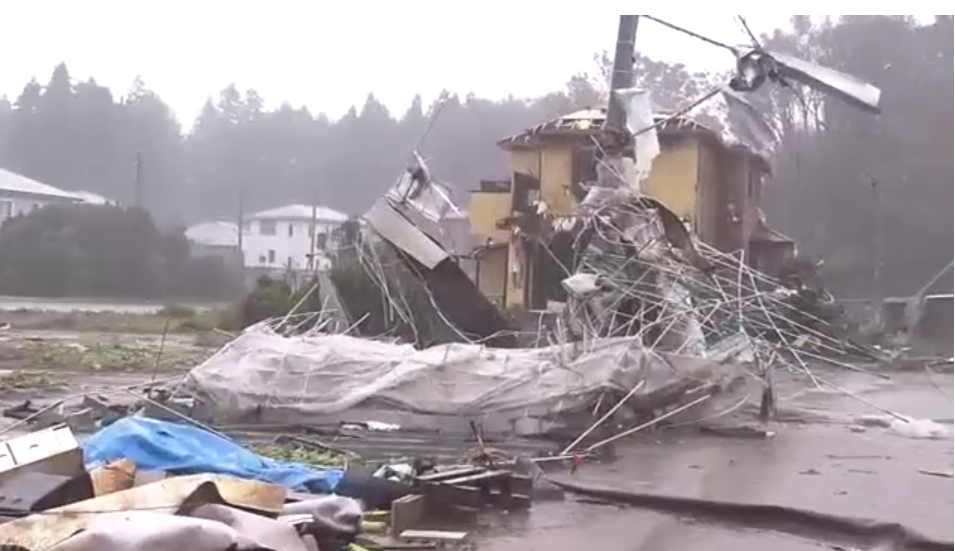Powerful Typhoon Hagibis lashes wide areas of Japan
 |
Devastating scenes in Japan overnight. Photo: JTWC/SATOPS/AP Images/NHK
With Typhoon Hagibis set to make landfall later Saturday, hundreds of thousands of households were advised to evacuate due to fears of flooding. The storm could bring the heaviest rain and winds to the nation in 60 years.
A man in Ichihara, Chiba Prefecture, was killed at around 9:30 a.m. Saturday (local time) when his vehicle flipped over. The man was taken to a hospital, where he was later pronounced dead, NHK reported. The incident occurred near an area where a tornado had earlier hit the, injuring at least four, including two children.
A number of municipal governments issued evacuation advisories to areas particularly at risk, including many in the Tokyo region. The storm’s effects were being seen across wide areas of Japan, including central prefectures like Aichi and Mie.
The typhoon is due to make landfall on Japan’s main island of Honshu late on Saturday, a month after one of the strongest typhoons to hit the country in recent years destroyed or damaged 30,000 houses and caused extensive power outages.
Stores, factories and train lines have been shut down as a precaution, while Japanese Formula One Grand Prix organizers canceled all practice and qualifying sessions scheduled for Saturday.
Two matches of the Rugby World Cup due to be played on Saturday were also canceled.
 |
The sky in Japan turned purple hours before the wrath of Super Typhoon Hagibis.
Storm surges are expected along the Pacific coast of Honshu on Saturday and Sunday along with torrential rain, raising the risk of floods and landslides.
The storm, which could dump amounts of rain not seen since a deadly typhoon in 1958, is expected to make landfall on the Pacific coast of central Japan or eastern Japan on Saturday evening, the Meteorological Agency said.
The projected path of the typhoon may result in further damage to areas in Chiba Prefecture, where another powerful typhoon triggered widespread power outages in September.
As of 10 a.m. Saturday (local time), Typhoon Hagibis was traveling north at a speed of 25 kph, some 230 km southwest of Hachijo Island in the Pacific. It had an atmospheric pressure of 945 hectopascals at its center and was packing gusts of up to 216 kph.
The typhoon is forecast to bring winds of 216 kph to the Tokai and Kanto-Koshin regions, including the Tokyo area, and could potentially severely damage homes, the weather agency warned.
Tokyo Electric Power Company Holdings Inc. said damage to a power-transmission line caused a brief power outage in Chiba. As of around 10:30 a.m., about 8,800 homes were without power in Tokyo, Chiba and two other prefectures in its service area.
Up to 1,000 mm of rain is expected in the Tokai region, and 600 mm in the Kanto-Koshin region, in the 24-hour period through midnight Saturday, the agency said.
There will be no shinkansen service between Tokyo and Nagoya on Saturday. Just six early-morning trains operated between Nagoya and Shin-Osaka, and operations between Shin-Osaka and Okayama will be canceled from the afternoon.
East Japan Railway Co. and private railways said they would gradually suspend train runs in the Tokyo area from Saturday morning and halt services.
 |
With flights cancelled, stores scheduled to close and public transport coming to a halt, we urge everyone in Hagibis' path to stock up on essentials and exercise caution. Ảnh: Nguyen Duc Vu
All Nippon Airways Co. said it will cancel all domestic flights and most international flights to and from Tokyo’s Haneda and Narita airports on Saturday. Japan Airlines Co. has also decided to cancel most of its flights on Saturday.
According to the weather agency, the predicted rainfall amounts would be in line with those deposited by Typhoon Ida in September 1958, which left 1,200 people dead or missing across Japan.
That storm, known as the Kanogawa Typhoon in Japan, ripped through the Kanto region and the Izu Peninsula, causing the Kano River in Shizuoka Prefecture to overflow./.
Reuters, Kyodo, Japan Times
Recommended
 World
World
‘We stand with India’: Japan, UAE back New Delhi over its global outreach against terror
 World
World
'Action Was Entirely Justifiable': Former US NSA John Bolton Backs India's Right After Pahalgam Attack
 World
World
US, China Conclude Trade Talks with Positive Outcome
 World
World
Nifty, Sensex jumped more than 2% in opening as India-Pakistan tensions ease
Popular article
 World
World
Easing of US-China Tariffs: Markets React Positively, Experts Remain Cautious
 World
World
India strikes back at terrorists with Operation Sindoor
 World
World
India sending Holy Relics of Lord Buddha to Vietnam a special gesture, has generated tremendous spiritual faith: Kiren Rijiju
 World
World



